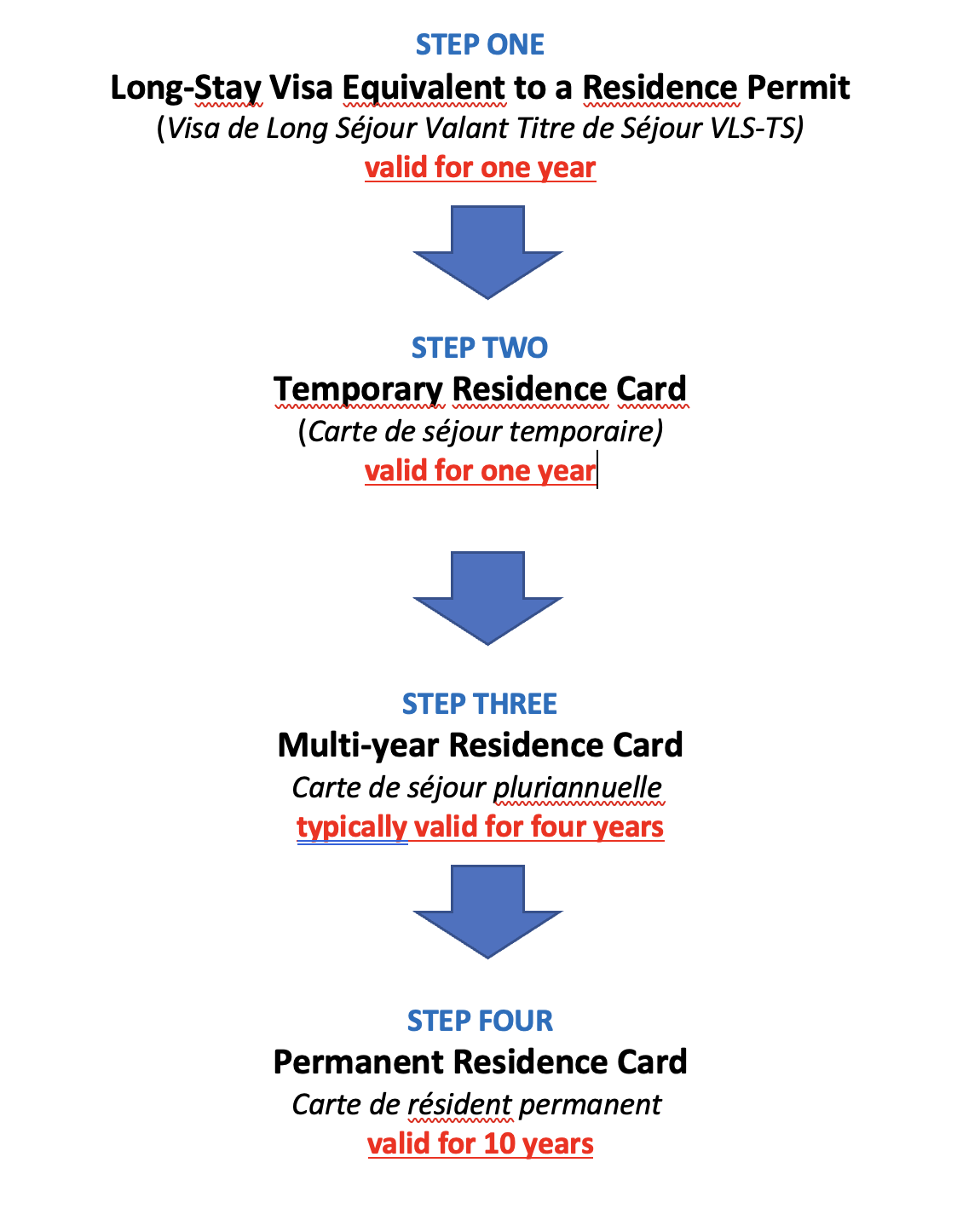The Road to Permanent Residency in France: A Step by Step Overview
Essential Reading


Moving or retiring to France has long been a dream for foreigners, but if you’re not a citizen of a European Union (EU) or European Economic Area (EEA) country (which now includes British citizens after Brexit), the road to permanent residency in France can be a lengthy process.
Your right to become resident in France will depend upon a number of factors, and you will need to undertake several different steps (and a whole lot of paperwork!) to finally secure your Carte de Résident – your permanent residency card.
Let’s take a look at the practical steps you will need to take to become legally resident in France.
How To Become a Permanent Resident in France
The first thing to prepare yourself for is that the road to permanent French residency is a long one – prepare yourself for a minimum of three years and a hefty amount of paperwork, regardless of your situation.
The time taken, costs involved, and eligibility requirements all vary depending on your personal circumstances – for example, a retiree, a worker on a talent visa, and the spouse of a French national – however, the steps are essentially the same.
IMPORTANT: Please note that this article is designed as a reference point only. You can find the official details of all visas and carte de séjours on the French government site here, and this should always be your first port-of-call for official information and the latest fees/requirements. However, hopefully, our explications will help you understand the key points.
The Main Steps to French Residency

Let’s take a look at each step in greater detail.
#1 Long-Stay Visa Equivalent to a Residence Permit
(Visa de Long Séjour Valant Titre de Séjour VLS-TS)
Depending on your personal situation, there are several different routes to residency, but all of them start with a long-stay visa. Regardless of whether you are moving to work or study, retiring to France, or joining a French or EU spouse or family member, you will still start the process to residency with a 1-year long-stay visa.
The kind of visa you need to apply for is a Long-Stay Visa Equivalent to a Residence Permit (Visa de Long Séjour Valant Titre de Séjour or VLS-TS). However, there are several different types available. Take a look at our article French Long-Stay Visas: Categories, Eligibility, & Application Process to find out which visa is the right one for your situation, then use our step-by-step guide to applying for your long-stay visa. This visa must be applied for in your country of residence or citizenship before your arrival in France.
One important thing to note is that the type of long-stay visa you apply for will also be the type of carte de séjour you apply for – in other words, if you apply for a visitor long-stay visa which does not entitle you to work, you will not later be able to apply for a carte de séjour that allows you to work (unless your circumstances have changed – see below). Therefore it is crucial to consider which long-stay visa is right for you both now and over the next few years.
It is possible to apply for a different Carte de Séjour if your circumstances have changed–for example, you arrive on a study visa, then are offered a job, or you arrive on a visitor visa, then marry a French national and wish to apply for a spousal visa. After five years in France, you may apply for permanent residency, which grants you the right to live, work, or study in France.
Validating your VLS-TS in France
Your long-stay visa VLS-TS must be validated within three months of arriving in France, which can be done online here – you will need to enter the information on your visa and additional personal information, give your date of arrival in France and your French address, and pay the state tax of €200.
OFII Medical
You will also be contacted by the OFII (French Office for Immigration and Integration) to carry out a medical. This report is compulsory if you plan to apply for a resident card (carte de séjour) at the end of your long-stay visa.
Details of the medical (as taken from the official guidelines) are:
The medical consists of a general clinical examination, an x-ray of the lungs, a vaccination check, and a blood glucose test for those at risk of diabetes. Additional examinations may be requested by the doctor. Health advice and information on the health system in France may be given.
At the end of the medical examination and the various examinations, a medical certificate certifying that you meet the medical conditions authorizing your stay in France will be issued to you. You will need to provide this medical certificate to the prefecture where you live in order to obtain the renewal of your residence card.
#2 Temporary Residence Card
(Carte de séjour temporaire)
In almost all cases (including for spouses and family members of French nationals), your first Carte de Séjour will only be valid for one year. Between four – two months of its expiry, you will need to apply for a renewal.
TIP: A Carte de séjour and Titre de séjour are essentially the same thing – the ‘titre’ refers to the permit, and the ‘carte’ refers to the card that is issued as proof of the permit – but you can’t have one without the other, so it’s easiest to assume they mean the same thing.
Applying for your first Carte de Séjour
The request for your first Carte de Séjour or Carte de séjour temporaire must be submitted between four to two months prior to the end of your long-stay visa. The application process can be done online here (click ‘Je demande ou renouvelle un titre de séjour’), and you can use the same account which you created when validating your long-stay visa. The whole process is carried out in France; you don’t need to return to your home country.
You will be asked to submit a number of documents (many of which you will already have had to submit for your original long-stay visa, but you will have to re-submit them) and pay the application fee of €225. In order to receive your first Carte de Séjour, you will also need to attend an interview at your local prefecture, where you will be asked to submit documents and have your biometric data taken.
Read our full guide Becoming a French Resident: How to Apply for a Carte de Séjour for more.
#3 Multi-year Residence Card
Carte de séjour pluriannuelle
The second Carte de Séjour you will apply for will be a multi-year ‘pluriannuelle’ card, which is typically valid for four years (this may vary in certain circumstances, for example, a student Carte de Séjour may be issued for the length of your study term only).
The process for this is the same as for your first Carte de Séjour – you can start the process online here (this time selecting the option ‘Carte de séjour pluriannuelle’), four to two months before the expiry of your 1-year Carte de Séjour. You will again be asked to provide documents proving that your situation has not changed and will need to attend an appointment at your local prefecture.
After your application has been approved, you will likely be issued a ‘récépissé’, a receipt that proves you have applied for a renewal. This will cover you in the event that your Carte de Séjour runs out while you are waiting for the renewed card.
TIP! Many expats report Carte de Séjour renewals to be a far easier process – assuming your situation has not changed; many people will find this is simply a case of providing the necessary documentation. However, this may not be the case for everybody, so it’s important to prepare for your appointment just as diligently as the previous times. If your situation has changed in any way – expect to be asked for documentation to cover this.
#4 Permanent Residence Card
Carte de résident permanent
The final step to your journey to permanent residency is a ‘Carte de résident permanent’, which you can apply for within three months of the expiry of your Carte de séjour pluriannuelle.
The minimum time you must have been living in France to apply for a Carte de Résident is five years; this is reduced to three years for the spouses or family members of a French national. This card is valid for 10 years and is renewable, effectively serving as a permanent residence.
The process for this is the same as for your first Carte de Séjour – you can start the process online here (this time selecting the option ‘Carte de séjour résident). You will again be asked to provide documents proving that your situation has not changed and will need to attend an appointment at your local prefecture. Depending on the type of Carte de séjour resident, you may also be asked for additional documents to prove your ‘integration into French society’ and also your French language skills.
Applying for French Nationality
If you have been in France for five years, an alternative option to applying for your 10-year residency card is to apply for French Nationality, i.e., to become a French citizen.
Additionally, you may do this at any time after five years of continuously living in France.
Applying for French nationality is not a mandatory step to permanent residence; however, it does have some benefits. If you receive French citizenship, you will also become an EU citizen, and may enjoy freedom of movement to live and work throughout the EU. You also won’t lose your French citizenship if you decide to live overseas for an extended period (which can happen with permanent residency). French citizenship also means you can apply for a French passport, apply for jobs only open to EU citizens, and have the right to vote.
How Much Does It Cost to Become Resident in France?
The following is a rough outline of the costs of the various visas and residency cards needed to become resident in France. Note that it does not account for the additional costs of health insurance and sufficient funds that may be required for some visa applications. It also does not include the cost of translating any official documents into French (which is required at some points in the application process), so be sure to factor this into your calculations. Bear in mind that these fees will be split up over several years.
Note that in some cases, for example, in the case of a spousal visa, these fees are waived; some study visa fees are also reduced. The following is included only as a reference – these fees are subject to change.
Long-stay visa application: €99 (an additional processing fee may also be added – currently £26 in the UK and $38.20in the US. Courier fees may also be charged if you require your visa to be posted to you – currently £16 in the UK).
Long-stay visa validation: €200 payable within three months of your arrival in France
Carte de Séjour temporaire : €225 (€200 tax and €25 stamp duty) payable when you apply for your Carte de Séjour (end of the first year)
Carte de Séjour pluriannuelle: €225 (€200 tax and €25 stamp duty) payable when you apply for your Carte de Séjour (end of the second year)
Carte de Séjour permanent: €225 (€200 tax and €25 stamp duty) payable when you apply for your Carte de Séjour (end of your 6th year in France, assuming that you received a 4-year Carte de Séjour pluriannuelle).
Moving to France?
From applying for your visa and opening a French bank account, to integrating in your new community – FrenchEntrée is here to help! Let our Essential Reading and Visa & Residency articles guide you through the whole process, then visit our Owning Property, French Tax, Healthcare, and Life in France zones for everything else you need to know.
Disclaimer: Our Essential Reading articles are designed to give an overview of the visa requirements and procedures for moving to France. We always check our information against the official government information made available to the public, however, please remember that all visa applications are considered on an individual basis and the exact requirements, fees, or application procedure may vary. Unless you are an EU citizen, obtaining a French visa is not a right, and we cannot guarantee that your visa will be approved.
Share to: Facebook Twitter LinkedIn Email



